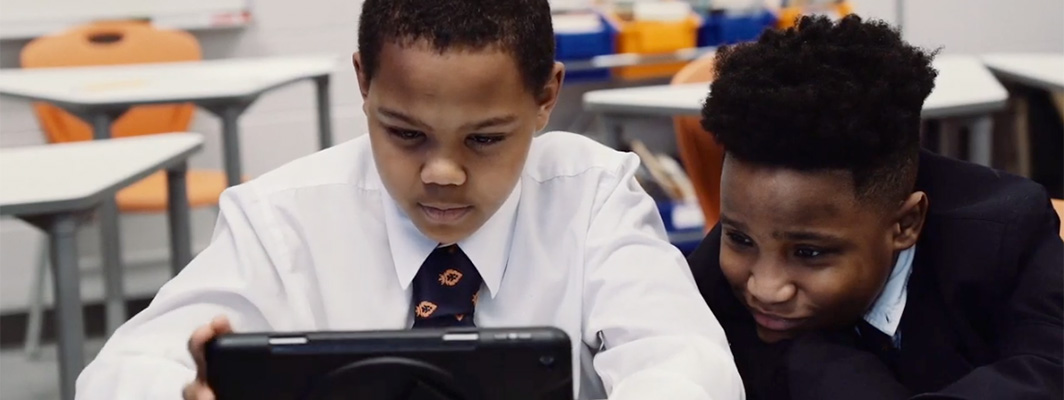
As the executive director of the Verizon Innovative Learning Schools (VILS) program, I had the opportunity to participate in professional development workshops, calls with coaches and IT personnel, and other virtual convenings supporting our community members from the 264 schools in our network. I heard first-hand about the challenges from teachers, coaches, and school leaders, but I also heard the innovative solutions that were put in place when they had to pivot quickly, including:
From a recent survey of participating schools conducted by our partner Westat, we learned that for schools already providing one-to-one devices for students and teachers, having prior experience integrating technology for powerful learning made the transition to remote learning smoother. Specifically, 71 percent of teachers felt they were prepared to shift to remote learning, and 93 percent credited the Verizon Innovative Learning Schools program with preparing them for remote instruction. Verizon Innovative Learning students, teachers, and parents were used to using a learning management system to get assignments, submit work, and ask questions. Students and teachers were familiar with apps that supported instructional goals and allowed them to demonstrate learning on their own.

“Because we are a part of VILS, making that transition was not difficult at all because we were already using the [devices] with the students as it is,” said one teacher from Cohort 6. “The only difference is we are not in the classroom and they feel comfortable; it helps that the students have that experience.”
“When I talk to other teachers that are not [at VILS schools], they have really struggled and I’ve been able to help out because I’ve been working like this for so long,” said a Cohort 4 teacher. “I couldn’t even imagine if I was not in the situation that I’m in, having been a part of the program for a few years now.”
While many districts figured out ways to support educators in their schools, others did not. With additional support from Verizon, we launched Teacher Training Pathways to fill that need for any educator looking to reinforce or improve their instruction in this new setting.
Despite how difficult this shift was for everyone involved, we can’t think about going back to the way things were. Most districts have figured out how to temporarily narrow the digital divide by creating a patchwork of coverage achieved by distributing classroom devices, purchasing some new ones, and buying hotspots. This has been a necessary but insufficient solution created out of urgency and with the idea that when the virus subsides, schooling will go back to “normal.” But the old normal didn’t address the digital divide, and even in places that did figure out access to technology and the internet, a second and larger gap, the Digital Learning Gap, persists.
The Digital Learning Gap is caused by differences in how learners in and out of school access and use technology to improve learning opportunity and outcomes. To help ensure powerful learning opportunities for all are supported by technology, we must understand and work to close this gap. There are three parts to the problem: access, participation, and powerful use.
The Digital Learning Gap existed long before the pandemic; COVID-19 just brought it to light for the general public. We must use this crisis to create a better and more equitable system for all learners, regardless of race, socioeconomic status, geography, or learner variability. If we are not careful and intentional, we will create an insurmountable gulf, leaving these students a bridge too far from their affluent peers that no amount of time, money, or intervention will resolve in their lifetime.
Fortunately we have seen possibilities become reality in our Verizon Innovative Learning Schools, where one-to-one devices are provided along with up to four years of data, as well as ongoing professional learning for all teachers. School culture, student learning, and teacher practices have all been shifted by leveraging technology for powerful learning:
William Hawley Atwell Law Academy in Dallas, Texas, used technology as an integral part of their school improvement plan and made sufficient gains to come out of Improvement Required status after only one year as a Verizon Innovative Learning School. Moreover, Ocala STEAM Academy in San Jose, California, was able to leverage technology to increase their rate of improvement as a result of learning continuing beyond the school day with their take-home devices.
To be clear, technology in and of itself won’t change anything, but the absence of access to it can change everything. Every child should have the opportunity to attend a school where a strong instructional leader with a clear vision for school transformation who supports teachers and learners creates a culture of powerful learning where gaps can narrow and opportunities expand. This should be the new normal.
Learn more about the Verizon Innovative Learning Schools program and apply to become a Verizon Innovative Learning School. Any educator looking to improve or reinforce their instruction in the remote setting can register for our free Teacher Training Pathways and Techno Tuesday webinars.